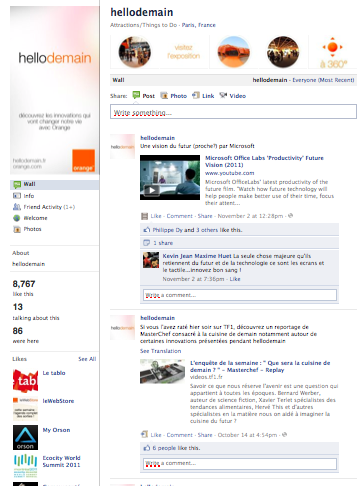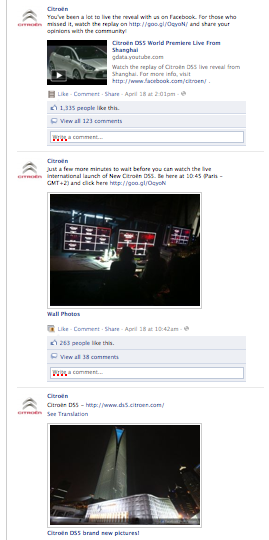I chose to review the e-performance barometer 2011, a study designed to measure the performance of the players in the online wine market. It reveals information about the e-commerce sector in the wine industry such as online shoppers criteria or efficiency. The results of this study come out every two years since 2007, when the city of Bordeaux welcomes Vinexpo – the most important worldwide Wine Professional exhibition.
This study is produced by Gregory Bressolles, Professor of marketing at BEM – Bordeaux Management School, and ends with a list of the best websites for online wine sales in France and throughout the world.
In this review I will talk about the world results, more than the French ones and state some information given about the market. This study is a brand new element in for the wine e marketing. Wine is indeed a very particular product for which online sales is only in the first phases. There are a lot of barriers to wine sell online compared to other products, such has storage issues, logistic issues, lack of formation and information for the consumer and the fact that it is almost a “luxury” product or perceived as one which means more built upon front relationship with the sellers or relied on deep habits and knowledge of a particular product (“I now this wine is good”). However this market continues to grow and reveals interesting business opportunity for the best players.
Wine market on the Internet
The online wine markets is worth 2 billion dollars worldwide which represent 5% of global wine sales across all distribution channels. The market is still dynamic and did not suffer from the economical crisis. Its annual growth stands steadily over 30% since 2007.
The market is divided into pure players and click&motars, but only few are significantly profitable. For example in France more than 200 e-commerce sites share a 100 million euro market and only 3 players generate a turnover of more than 5 million euro each (1885.com, Chateauonline.com and WineandCo.com). There is an important turnover rate of companies for a share of online sales remaining marginal compared for example to supermarket. The market does not seem to be organized. These elements are indicators that confirm the revolution in the online wine sales market is not over yet.
The Internet channel is considered as a key success factor for the industry. They seem to be aware that they have to build a relationship of trust with the consumer if they want to overcome the inherent difficulties associated with online wine retail.
Study Methodology
In 2010 3,000 Internet users from 8 different countries have been involved. They came from Europe with France, Spain, Germany and UK, but also from the USA, Australia and China. The sample was composed to reflect the potential customers of the different websites studied, with 73% men, 43% came from the higher socio-professional groups and 73% had a high net annual household income (69% more than 30,000 euros).
At least 100 Internet users have to evaluate each one of the 28 different websites. This evaluation relies on 7 different criteria:
- Information: measure the level of relevance and detail of the information available. This criteria is determinant when it is not possible to touch the product before purchasing.
- Security/privacy: it refers to the level of trust in the privacy protection and the level of security the Internet users gives to the website. This criteria is important to transform a “visitor” to an actual “consumer”.
- Reliability: it goes with the respect of commitments taken by the website. It is a very important aspect to evaluate online purchasing performance. The website should produce information about delivery conditions and time, products availability, ordering process…
- Ease of use: measures the usability of a website and the degree of which the web user is able to find information he is looking for. This criteria is very important because it determines both the effectiveness of the “information” one and the “reliability” one… but almost all the other criteria linked to providing information.
- Offer: measures the diversity of the website offer. This criteria also takes into account the eventual promotions offers available on the website.
- Interactivity/personalization: measures the degree of interactivity and personalization of the website. Some example could be: newsletter subscribing, private access possibilities or easy to contact the company…
- Design: esthetical criteria (photos, illustration, quality and respect of graphic guidelines)
The 28 websites were: 20 French, 2 English, 1 Italian, 1 German, 1 Spanish, 1 American.
Results
The results enabled the study managers to create 3 groups of websites.
The top 5 in the world composes the first group. They were able to build a strong relationship with their users. It appears that the “ease to use” and information criteria are both much more mastered than the worldwide average, apart from design and ease to use – which seem to be determinant.
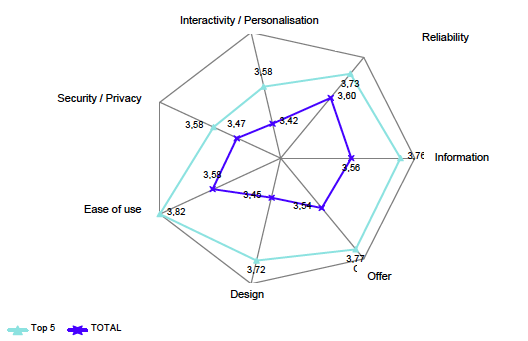
The mid-range rated sites focus on Reliability, Information and Offer. The websites of this group are very close to the average profile.
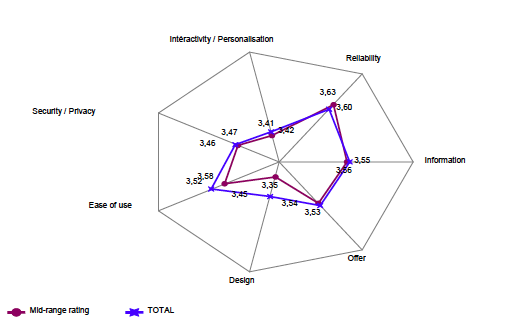
11 sites compose the bottom of the league. They have received the most negative evaluation in almost all the performance aspects. Their scores in design and interactivity are particularly low.
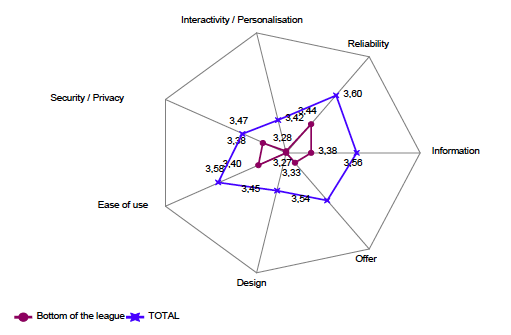
Best wine online websites
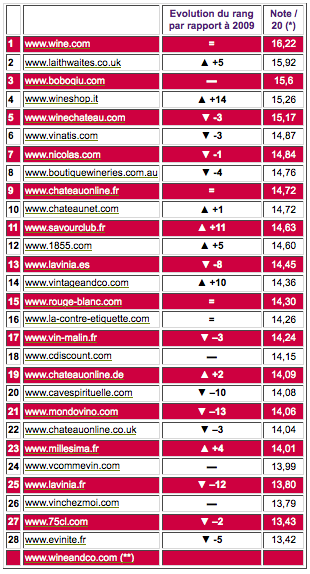
Limits and interest of the study
I found this study very interesting because it concerns a new online market. The wine is not matured online and it is still possible to see how it is growing, the different business opportunities and to study why some websites manage to reach profitability while others don’t. From the same point of view, this study does not concentrate on the number of visits but deeply on the web user behavior and appreciation of a system. The use of the different criteria make it possible to understand why people use more a website than another in terms of quality more than in terms of traffic success or turnover. From the service experience, this study is very interesting.
On the other hand it only concerns a small sample of both websites and web users because only 100 users analyze each website. Moreover, the sample is representative of the online wine buyers in general and not of the particular target of the analyzed website. The three different editions of this study (2007, 2009 and 2011) show the same structure and did not evolve that much from year to year – neither the methods nor the criteria or the size of the sample. This study is a very interesting tool for the industry and online selling’s in general but its managers should consider enriching it if they want to keep it conform to the market reality.
Source of article: DP-2007, http://www.eperformance-barometer.bem.edu/etude_2011.php
ANNEXE
Best practices
I found interesting to extract all the best practices suggested by the study in 2007. Source: DP e-performance Barometer
Information: Describe each wine accurately via an illustrated information card (labels, …). Give details on the different vintage years. Provide flavour ratings (site wine steward and / or independent guides), the characteristics of the soil, a brief description of the land, flavour advice, information on the storage potential of the wine or information on food accompaniment. Offer multilingual support and have an individual marketing approach for each country.
Offer: Develop and update the range regularly, Internet users always like to discover new wines and this enables the retailer to generate loyalty. Offer a large range of products with different prices and characteristics. Allow the Internet user to order a single bottle and not an entire case at once. Put in place promotions to stimulate sales.
Design: Use multimedia channels to make online retail less dry (videos, animations…). Offer a graphic charter which is sober and consistent with the types of products sold and the positioning of the site.
Ease of use: Offer a user-friendly navigation interface. Facilitate the Internet user’s research by offering several search options (by price, region, grape variety, colours, occasion of consumption, etc.). Provide an internal search engine. The merchandising techniques applied to the Internet can be used (bringing topics to the forefront by use of “aisle-end displays”, etc.)
Security / Privacy: Offer various methods of payment and reassure the Internet user at the point of purchase (bank logos, quality seals, …). Allow easy access to the Terms and Conditions of Sale. Provide information regarding the data protection policy (possibility to unsubscribe from e-mailings, …).
Interactivity / Personalisation: Enable users to contact the site’s wine steward (e-mail, direct chat) in order to obtain answers to their questions. Provide videos of the producer’s vineyard in order to establish visual contact. Offer a parcel tracking service online. Use direct marketing techniques to get to know the client base better. Via e-mail, direct, rich and inexpensive communication can be established with the customer. Offering personalised newsletters, adapted to the expectations of the users, forms part of this approach. In order to build up loyalty, offer the best customers access to dedicated services (my favourite wines …).
Reliability: Indicate the level of stocks in real time. Offer a variety of delivery methods and timescales. Ensure the delivery can be tracked on the site and / or by e-mail so the customer is informed at every stage. Provide efficient and impeccable customer service in the case of breakages, delays in delivery …
